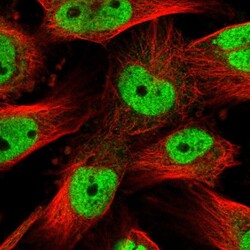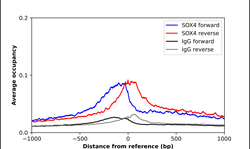Antibody data
- Antibody Data
- Antigen structure
- References [5]
- Comments [0]
- Validations
- Immunocytochemistry [1]
- Chromatin Immunoprecipitation [1]
Submit
Validation data
Reference
Comment
Report error
- Product number
- HPA029901 - Provider product page

- Provider
- Atlas Antibodies
- Proper citation
- Atlas Antibodies Cat#HPA029901, RRID:AB_10601592
- Product name
- Anti-SOX4
- Antibody type
- Polyclonal
- Description
- Polyclonal Antibody against Human SOX4, Gene description: SRY (sex determining region Y)-box 4, Validated applications: ICC, IHC, ChIP, Uniprot ID: Q06945, Storage: Store at +4°C for short term storage. Long time storage is recommended at -20°C.
- Reactivity
- Human
- Host
- Rabbit
- Conjugate
- Unconjugated
- Isotype
- IgG
- Vial size
- 100 µl
- Concentration
- 0.1 mg/ml
- Storage
- Store at +4°C for short term storage. Long time storage is recommended at -20°C.
- Handling
- The antibody solution should be gently mixed before use.
Submitted references Lineage specific transcription factor waves reprogram neuroblastoma from self-renewal to differentiation
Tumor Microenvironment Is Critical for the Maintenance of Cellular States Found in Primary Glioblastomas
Human Sox4 facilitates the development of CXCL13-producing helper T cells in inflammatory environments
Global transcriptional analysis identifies a novel role for SOX4 in tumor-induced angiogenesis
SOX4 can redirect TGF-β-mediated SMAD3-transcriptional output in a context-dependent manner to promote tumorigenesis
Banerjee D, Bagchi S, Liu Z, Chou H, Xu M, Sun M, Aloisi S, Vaksman Z, Diskin S, Zimmerman M, Khan J, Gryder B, Thiele C
Nature Communications 2024;15(1)
Nature Communications 2024;15(1)
Tumor Microenvironment Is Critical for the Maintenance of Cellular States Found in Primary Glioblastomas
Pine A, Cirigliano S, Nicholson J, Hu Y, Linkous A, Miyaguchi K, Edwards L, Singhania R, Schwartz T, Ramakrishna R, Pisapia D, Snuderl M, Elemento O, Fine H
Cancer Discovery 2020;10(7):964-979
Cancer Discovery 2020;10(7):964-979
Human Sox4 facilitates the development of CXCL13-producing helper T cells in inflammatory environments
Yoshitomi H, Kobayashi S, Miyagawa-Hayashino A, Okahata A, Doi K, Nishitani K, Murata K, Ito H, Tsuruyama T, Haga H, Matsuda S, Toguchida J
Nature Communications 2018;9(1)
Nature Communications 2018;9(1)
Global transcriptional analysis identifies a novel role for SOX4 in tumor-induced angiogenesis
Vervoort S, de Jong O, Roukens M, Frederiks C, Vermeulen J, Lourenço A, Bella L, Vidakovic A, Sandoval J, Moelans C, van Amersfoort M, Dallman M, Bruna A, Caldas C, Nieuwenhuis E, van der Wall E, Derksen P, van Diest P, Verhaar M, Lam E, Mokry M, Coffer P
eLife 2018;7
eLife 2018;7
SOX4 can redirect TGF-β-mediated SMAD3-transcriptional output in a context-dependent manner to promote tumorigenesis
Vervoort S, Lourenço A, Tufegdzic Vidakovic A, Mocholi E, Sandoval J, Rueda O, Frederiks C, Pals C, Peeters J, Caldas C, Bruna A, Coffer P
Nucleic Acids Research 2018;46(18):9578-9590
Nucleic Acids Research 2018;46(18):9578-9590
No comments: Submit comment
Supportive validation
- Submitted by
- Atlas Antibodies (provider)
- Main image

- Experimental details
- Immunofluorescent staining of human cell line U-251 MG shows localization to nucleoplasm.
- Sample type
- Human
Supportive validation
- Submitted by
- Atlas Antibodies (provider)
- Main image

- Experimental details
- ChIP-Exo-Seq composite graph for Anti-SOX4 (HPA029901, Lot D116454) tested in K562 cells. Strand-specific reads (blue: forward, red: reverse) and IgG controls (black: forward, grey: reverse) are plotted against the distance from a composite set of reference binding sites. The antibody exhibits robust target enrichment compared to a non-specific IgG control and precisely reveals its structural organization around the binding site. Data generated by Prof. B. F. Pugh´s Lab at Cornell University.
 Explore
Explore Validate
Validate Learn
Learn Immunocytochemistry
Immunocytochemistry Immunohistochemistry
Immunohistochemistry